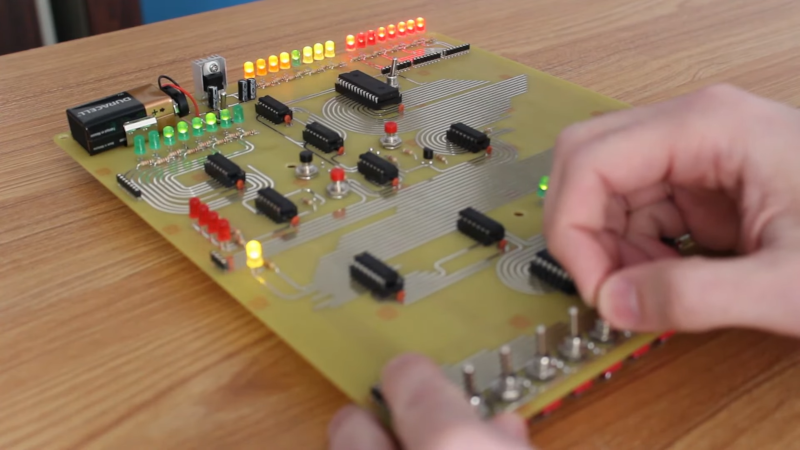While the world has been racing for higher and higher bit counts for CPUs, there are always those that buck the trend. Consider the venerable Motorola MC14500B, a 1-bit CPU, no kidding. [Usagi Electric] built up a computer based on one of these chips using a breadboard but has since pulled it apart to use the breadboard for other things. So this time, he’s made a permanent version on a PCB and created a simple game to show it off. You can see the result in the video below.
Well, the chip had one bit in the datapath. It did not have any memory, but it did have a way to feed it 4-bit instructions, and, as you might guess, there were 16 possibilities for instructions. The chip was meant to replace industrial controllers where even a PLC might be overkill, and apparently, it did see some use in the real world.
The board was made to look like a period-appropriate board. There are thick and curvy traces, widely separated, and there’s no solder mask, either. The finished board looks great and could easily pass for a 1970s-era development board. There were a few problems with the original board, but it all worked out in the end.
We know the little CPU showed up on at least one educational board. While you might think having a small CPU is a disadvantage, it isn’t if you are trying to build it using tubes.
















Handy to go with one’s 1-bit DACs.
https://www.stereophile.com/content/pdm-pwm-delta-sigma-1-bit-dacs
Well, it’s a bit better than nothing!
B^)
Last time I used one of those was at university nearly 40 years ago :-)
It was used to teach the basics of microcontrollers to us physics students. Even then, the novelty of a 1-bit machine wasn’t lost on us 8-bit fans.
Ah, the MC14500B.
I did a lift-control module using the processor many years back. It worked by having switches for each floor and limit switches at the top and bottom. It would start at the bottom and counting floors as it was going up and down, keeping track of the position based on the input from the floor switches and knowing the direction it was moving.
The first (pre-production) version worked quite well — apart from one slight little issue. To know where it was after being turned on, it had to re-calibrate (i.e. move to the bottom floor) so it had a reference point to start from. Unfortunately, I forgot to check whether the doors were closed before initiating the re-calibration, which led me to imagine a scenario where there had been a power outage while the doors were open and that an elderly person would be mid-step halfway in when power was restored and re-calibration would commence.
I’m sure you can provide your own imagery and sound track to this scenario.
I wire wrapped something with a 14500 many years ago, it was based on an Elektor magazine article, pretty much only the ICU and LEDs/switches, nothing too fancy. I always wanted to design a full system, alas time and family obligations prevented me so far. I have just a couple of weeks ago ordered this one which looked exactly like my dream project: https://www.tindie.com/products/nicola_cimmino/plc14500-nano-1-bit-single-board-computer-kit/ didn’t come around building it yet, so can’t comment much on it. Surprised though I didn’t see it on HaD, it’s well documented and OSHW certified: https://github.com/nicolacimmino/PLC-14500